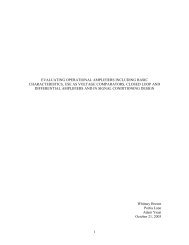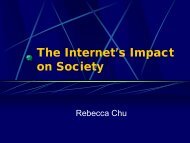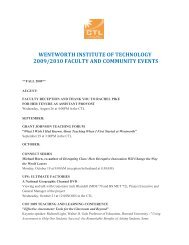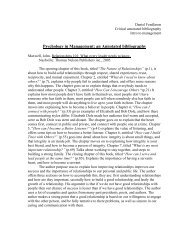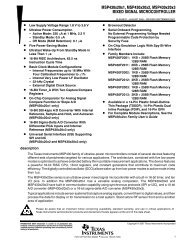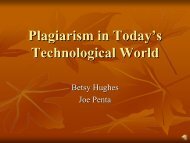International Journal of Art and Aesthetics in ... - DigitalFilm Tree
International Journal of Art and Aesthetics in ... - DigitalFilm Tree
International Journal of Art and Aesthetics in ... - DigitalFilm Tree
You also want an ePaper? Increase the reach of your titles
YUMPU automatically turns print PDFs into web optimized ePapers that Google loves.
tHe ARt oF ReLAtIonAL LeADeRsHIP<br />
In order to develop a more nuanced conception <strong>of</strong> the art <strong>of</strong> relational leadership, we<br />
will break down the phrase, discuss<strong>in</strong>g the parts <strong>of</strong> it <strong>in</strong> turn. We beg<strong>in</strong> with the idea<br />
<strong>of</strong> relational leadership, draw<strong>in</strong>g upon Mary Uhl-Bien’s (2006) approach. she breaks<br />
down relational leadership <strong>in</strong>to two theoretical approaches, an entity perspective <strong>and</strong><br />
a relational perspective. Although both are concerned with leadership as a phenomenon<br />
that <strong>in</strong>volves both leaders <strong>and</strong> followers, the entity perspective exam<strong>in</strong>es the<br />
relationship from the perspective <strong>of</strong> the <strong>in</strong>dividuals (the leader <strong>and</strong> followers). she<br />
identifies the entity perspective as be<strong>in</strong>g based <strong>in</strong> an ontology <strong>of</strong> objective truth <strong>and</strong><br />
be<strong>in</strong>g concerned with how the <strong>in</strong>dividual perceives <strong>and</strong> <strong>in</strong>fluences the relationship<br />
with the other. In contrast, the relational perspective is based <strong>in</strong> an ontology <strong>of</strong> social<br />
construction <strong>and</strong> is concerned with the relationship itself, which it sees as be<strong>in</strong>g constantly<br />
constructed <strong>in</strong> processes.<br />
We conceptualize relational leadership from Uhl-Bien’s relational perspective. one key<br />
consequence <strong>of</strong> the relational approach is that it moves the focus from underst<strong>and</strong><strong>in</strong>g<br />
leadership effectiveness to underst<strong>and</strong><strong>in</strong>g the relational processes by which leadership<br />
is produced, which fits with our concern with the craft <strong>of</strong> the art <strong>of</strong> leadership. In<br />
artistic terms, we are not so much concerned with a judgment <strong>of</strong> the quality <strong>of</strong> the<br />
f<strong>in</strong>ished pa<strong>in</strong>t<strong>in</strong>g, but rather what techniques <strong>and</strong> methods have been used to produce<br />
the pa<strong>in</strong>t<strong>in</strong>g <strong>and</strong> how those methods affect the f<strong>in</strong>ished pa<strong>in</strong>t<strong>in</strong>g.<br />
the idea that leadership is an art is certa<strong>in</strong>ly not new. Barnard told us, ‘It is a matter <strong>of</strong><br />
art rather than science, <strong>and</strong> is aesthetic rather than logical’ (1938: 235). Just look<strong>in</strong>g<br />
at our own bookshelf <strong>of</strong>fers titles such as the <strong>Art</strong> <strong>of</strong> leadership (Bothwell 1983), the<br />
<strong>Art</strong> <strong>and</strong> science <strong>of</strong> leadership (nahav<strong>and</strong>i 1997), the <strong>Art</strong> <strong>of</strong> the leader (cohen, 1990),<br />
the <strong>Art</strong>s <strong>of</strong> leadership (Gr<strong>in</strong>t 2001), <strong>and</strong> the three Faces <strong>of</strong> leadership: <strong>Art</strong>ist, Manager,<br />
priest (Hatch et al. 2004). there has been a gradual movement from us<strong>in</strong>g the<br />
idea <strong>of</strong> leadership as an art rather loosely, to more <strong>and</strong> more detailed use <strong>of</strong> specific<br />
aesthetic philosophy. As an example, Duke (1986) simply argued for four aesthetic<br />
properties <strong>of</strong> leadership. twenty years later, Ladk<strong>in</strong> (2006) is ga<strong>in</strong><strong>in</strong>g new <strong>in</strong>sights <strong>in</strong>to<br />
charismatic leadership by view<strong>in</strong>g it through Kant’s idea <strong>of</strong> the sublime, <strong>and</strong> samier<br />
<strong>and</strong> Bates (2006) are present<strong>in</strong>g a variety <strong>of</strong> specific philosophic stances on leadership<br />
<strong>and</strong> adm<strong>in</strong>istration. Although this movement has <strong>of</strong>fered deeper <strong>in</strong>sights <strong>in</strong>to<br />
leadership, it is important to recognize that it comes from a position <strong>of</strong> art criticism<br />
rather than art practice (taylor <strong>and</strong> carbone 2008). that is to say, it is based <strong>in</strong> an <strong>in</strong>tellectual<br />
approach to art that tends to be taken by academics <strong>and</strong> critics rather than<br />
an embodied approach that is taken by teachers <strong>and</strong> artists. the <strong>in</strong>tellectual approach<br />
is look<strong>in</strong>g for clear analytic <strong>in</strong>sight <strong>and</strong> conceptualization, while the practice approach<br />
is look<strong>in</strong>g for examples <strong>of</strong> embodied know<strong>in</strong>g which are particular to the situation, but<br />
<strong>in</strong> that particularity may <strong>of</strong>fer some useful <strong>in</strong>sight. As many creative writ<strong>in</strong>g teachers<br />
will say, the more specific <strong>and</strong> concrete the detail, the more it generalizes for the<br />
reader. As we speak <strong>of</strong> relational leadership as work<strong>in</strong>g connection, we are speak<strong>in</strong>g<br />
from an art practice perspective <strong>and</strong> our hope is to <strong>of</strong>fer specific practices rather than<br />
an analytic conceptualization <strong>of</strong> the art <strong>of</strong> relational leadership.<br />
When leadership is spoken <strong>of</strong> as an art, this is somehow different from an art<br />
such as pa<strong>in</strong>t<strong>in</strong>g, sculpture, or dance. the difference is that while every art is<br />
formative, that is the art is about form<strong>in</strong>g someth<strong>in</strong>g – the art <strong>of</strong> negotiation<br />
is about form<strong>in</strong>g an agreement <strong>in</strong> the face <strong>of</strong> conflict<strong>in</strong>g <strong>in</strong>terests, the art <strong>of</strong><br />
sculpture is about form<strong>in</strong>g sculpture out <strong>of</strong> marble or some other material<br />
– the ‘pure’ arts are about formativeness for the sake <strong>of</strong> form<strong>in</strong>g, while the<br />
applied arts have an <strong>in</strong>strumental purpose (strati 1999). so what does this<br />
mean when applied to managerial action such as leadership?<br />
Goodsell suggests that management is ‘an art <strong>in</strong> the ancient sense <strong>of</strong> that word, i.e.<br />
it embodies a specialized skill that is capable <strong>of</strong> creat<strong>in</strong>g results that are both usable<br />
<strong>and</strong> pleas<strong>in</strong>g to behold. specific objects are created <strong>and</strong> tasks performed, yet <strong>in</strong> ways<br />
<strong>and</strong> with consequences that establish <strong>in</strong> the m<strong>in</strong>ds <strong>of</strong> both creator <strong>and</strong> audience a<br />
sense <strong>of</strong> <strong>in</strong>tr<strong>in</strong>sic satisfaction, above <strong>and</strong> beyond the utilitarian purpose at h<strong>and</strong>’,<br />
but not necessarily unrelated to it (Goodsell 1992: 247). Kuhn says, ‘the process<br />
<strong>of</strong> ‘manag<strong>in</strong>g’ becomes art as those<br />
<strong>in</strong>volved create mean<strong>in</strong>g, construct form,<br />
recognize patterns, <strong>and</strong> place values on<br />
relationships with others. It is an art that<br />
exists only <strong>in</strong> process’ (Kuhn 1996: 223).<br />
We suggest that the primary medium<br />
that leaders form <strong>and</strong> work with <strong>in</strong> order<br />
to accomplish the <strong>in</strong>strumental goals<br />
<strong>of</strong> the organization is the connections<br />
between people.<br />
Although we have all seen or at least can<br />
imag<strong>in</strong>e how a pa<strong>in</strong>ter works with<strong>in</strong> one<br />
medium with their pa<strong>in</strong>ts, brushes, <strong>and</strong><br />
canvas to create a pa<strong>in</strong>t<strong>in</strong>g, what it actually<br />
means to work connection is less<br />
clear. We cannot see, touch, taste, smell,<br />
or hear connection. But we can feel connection.<br />
What does it mean to feel connected<br />
to each other? to feel someth<strong>in</strong>g<br />
implies a way <strong>of</strong> know<strong>in</strong>g that is <strong>in</strong>tuitive<br />
<strong>and</strong> holistic (Beardsley 1982), a way <strong>of</strong><br />
know<strong>in</strong>g that is unmediated by deductive<br />
or <strong>in</strong>ductive reason<strong>in</strong>g (csikszentmihalyi<br />
<strong>and</strong> Rob<strong>in</strong>son 1990), a way <strong>of</strong> know<strong>in</strong>g<br />
the ‘felt mean<strong>in</strong>g’ (courtney 1995) <strong>of</strong> an<br />
experience; all <strong>of</strong> which are also descriptions<br />
<strong>of</strong> aesthetic experience.<br />
the most common conception <strong>of</strong> aesthetics<br />
with<strong>in</strong> organizational aesthetics<br />
is as the study <strong>of</strong> sensible know<strong>in</strong>g<br />
that is apprehended directly by the five<br />
senses. As Ramirez puts it:<br />
‘<strong>Aesthetics</strong> is that branch <strong>of</strong> Western<br />
philosophy that deals with the forms <strong>of</strong><br />
underst<strong>and</strong><strong>in</strong>g, perception, conception,<br />
<strong>and</strong> experience which we qualify (<strong>of</strong>ten<br />
after the fact) with adjectives such as<br />
‘beautiful’, ‘ugly’, ‘elegant’, or ‘repulsive’.<br />
Aesthetic knowledge depends largely<br />
on sens<strong>in</strong>g <strong>and</strong> feel<strong>in</strong>g, on empathy <strong>and</strong><br />
<strong>in</strong>tuition, <strong>and</strong> on relat<strong>in</strong>g conception to<br />
perception’. (Ramirez 2005: 29)<br />
However, there is another way <strong>of</strong> th<strong>in</strong>k<strong>in</strong>g<br />
about aesthetics that explicitly l<strong>in</strong>ks<br />
connection <strong>and</strong> aesthetics. this conceptualization<br />
<strong>of</strong> aesthetic experience<br />
comes from Ramirez’s (1991) concept<br />
<strong>of</strong> the beauty <strong>of</strong> social organization.<br />
Ramirez starts by develop<strong>in</strong>g a systems<br />
theory <strong>of</strong> organizational beauty. Be<strong>in</strong>g ‘a<br />
part <strong>of</strong>’ a system simultaneously means<br />
‘belong<strong>in</strong>g to’ <strong>and</strong> ‘dist<strong>in</strong>ct from’. the<br />
aesthetic experience <strong>of</strong> beauty comes<br />
from the feel<strong>in</strong>g <strong>of</strong> ‘belong<strong>in</strong>g to’. or<br />
as Bateson said, ‘By aesthetic, I mean<br />
responsive to the pattern that connects’<br />
m<strong>in</strong>d <strong>and</strong> nature (quoted <strong>in</strong> Ramirez,<br />
1991: 38). s<strong>and</strong>el<strong>and</strong>s (1998) expresses<br />
// 3 AestHesIs Vol. 2 // tWo: 2008





